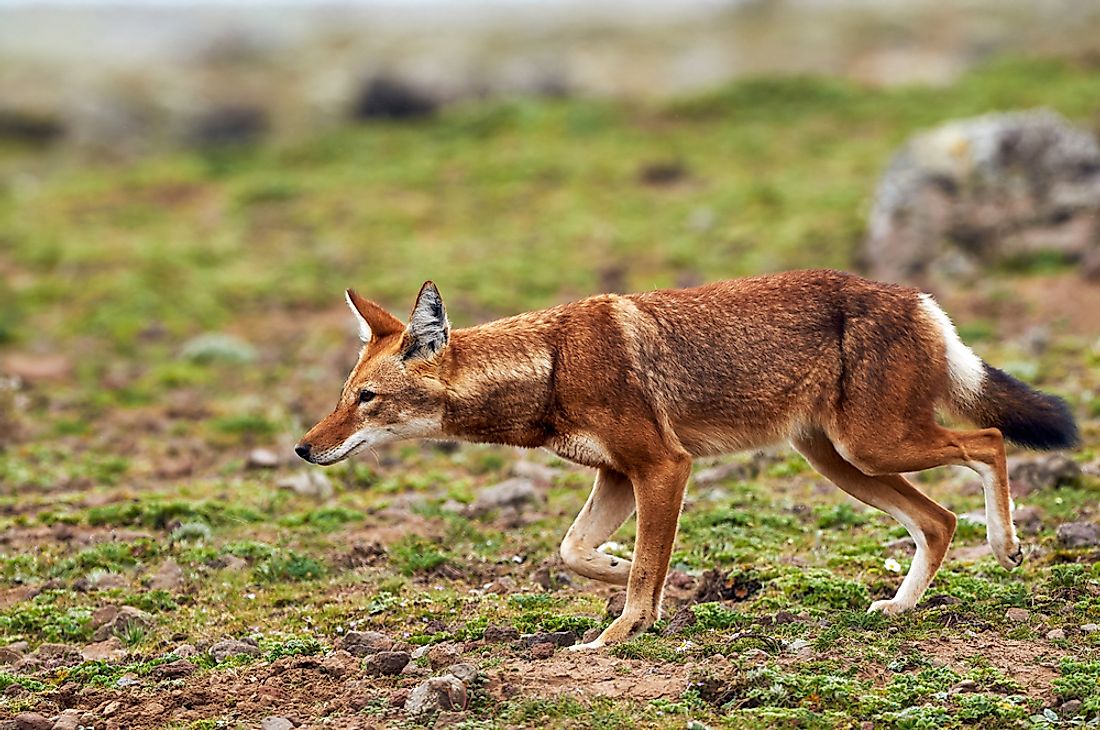Ethiopian Wolf Facts - Animals of Africa

The Ethiopian Wolf is a small canid animal native to the Ethiopian mountains in East Africa. The Ethiopian Wolf is the most endangered carnivore in Africa and is among the rarest canids in the world with only 500 remaining in the wild comprised of about 250 breeding individuals.
4. Physical Description
The Ethiopian Wolf has a small build, long, slender legs and a thick fur coat suited for the cold habitats where it is located. The coat is usually reddish-brown with a whitish-ginger underfur which extends to the chin. However, juvenile wolves have a charcoal-grey coat which gradually changes to bright tawny red. The coat on females changes to become more yellowish during the breeding season. The Ethiopian Wolf has a large black bushy tail. The Ethiopian Wolf is a coyote-sized canid with the body length in adults ranging between 33.1 inches and 39.8 inches. Sexual dimorphism is present in the Ethiopian Wolf where males are relatively larger than females with the weight in males ranging between 31 pounds and 43 pounds while the weight in females range between 24.7 pounds and 31.2 pounds. The wolf has a small, elongated skull and widely-spaced teeth featuring 14-millimeter canine teeth.
3. Diet
Rodents are the bulk prey items of the Ethiopian Wolf. The preferred prey is the big-headed mole-rats which are endemic in the wolf’s habitat range. Other prey items include Highland hare, grass rats, vlei rats, yellow-spotted brush-furred rats, and black-clawed brush-furred rats. However, the Ethiopian Wolf has been documented taking down mountain nyala calves and rock hyraxes. While the wolf is primarily a predator, it has been known to scavenge on carcasses. The wolf also ingests sedge leaves which are believed to be used for parasite control or as a source of roughage.
2. Habitat and Range
As its name denotes, the Ethiopian Wolf is only found in high altitude regions of Ethiopia. The wolf prefers mountainous regions above the tree line on heathlands and the afro-alpine grasslands due to the abundance of its main prey item the afro-alpine rodents. The wolf’s range has been shrinking due to increased human activities in the mountains with the existing population of wolves being restricted to the high peaks. The Bale Mountains and the Simien Mountains have the largest population of the wolves with over 50% of the total population.
1. Behavior
The wolf is a social animal and lives in packs which can have up to 20 individuals. The average amount of wolves in a pack is six. Each pack is hierarchal, with a single breeding male and female and other females being reproductively suppressed. In the event of the death of the dominant female, her place is taken over by a daughter. Each pack is entitled to a territory which covers an average of 2.3 square miles and members of the pack conduct border patrols and leave scent markings. The mating season takes place between August and November and involves the breeding male and female involving courtship where the breeding male regularly follows the breeding female. The gestation period in Ethiopian wolves is about two months, after which a litter of two to six pups is born between October and December. The majority of the female wolves disperse from the group after they attain the age of two to avoid inbreeding.







